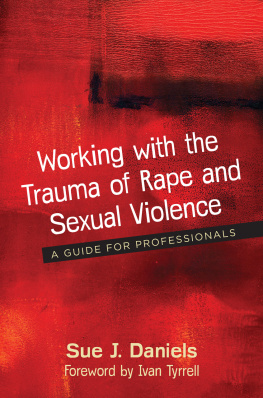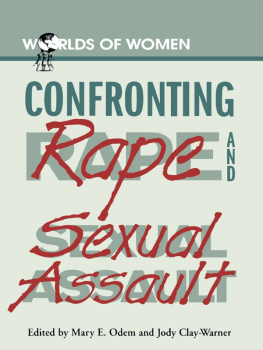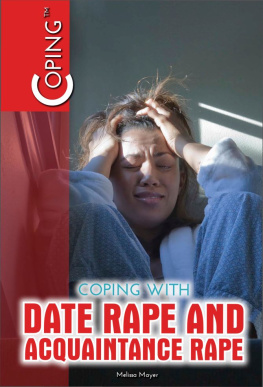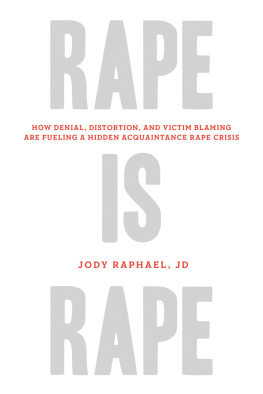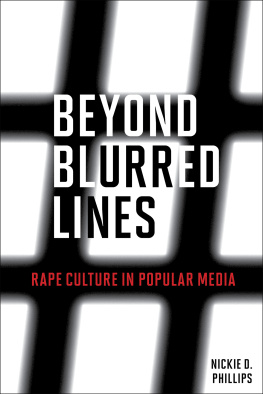Framing the Rape Victim
Framing the Rape Victim
Gender and Agency Reconsidered
Carine M. Mardorossian
Rutgers University Press
New Brunswick, New Jersey, and London
Library of Congress Cataloging-in-Publication Data
Mardorossian, Carine M., 1966
Framing the rape victim : gender and agency reconsidered / Carine M. Mardorossian.
pages cm
Includes bibliographical references and index.
ISBN 9780813566030 (hardcover : alk. paper) ISBN 9780813566023 (pbk. : alk. paper) ISBN 9780813566047 (e-book)
1. Rape victimsUnited States. 2. RapeUnited States. 3. WomenViolence againstUnited States. 4. Rape in motion pictures. I. Title.
HV6561.M367 2014
362.8830973dc23 2013029876
A British Cataloging-in-Publication record for this book is available from the British Library.
Copyright 2014 by Carine M. Mardorossian
All rights reserved
No part of this book may be reproduced or utilized in any form or by any means, electronic or mechanical, or by any information storage and retrieval system, without written permission from the publisher. Please contact Rutgers University Press, 106 Somerset Street, New Brunswick, NJ 08901. The only exception to this prohibition is fair use as defined by U.S. copyright law.
Visit our website: http://rutgerspress.rutgers.edu
Manufactured in the United States of America
For Kathleen Lerusse
Contents
I want to thank the activists and survivors, colleagues, and friends I met during my years as an anti-rape activist. These years overlapped with and extended into intense thinking and discussion surrounding feminist theory. To all those who were part of this journey in one way or another, I send my deeply felt gratitude: Amanda Anderson, Yves Clemmen, Sagari Dhairyam, Pascale Drianne, Anna Marie Gire, Kay Holley, A. J. Herzog, Stephanie Foote, Christine Levecq, Janet Lyon, Cris Mayo, and Faustina Robinson. Others have more recently been instrumental in helping me finish this project: Diane Christian, Robert Daly, Masani Alexis Deveaux, Bruce Jackson, Arabella Lyon, Carla Mazzio, Cristanne Miller, Gwynn Thomas, and Joseph Valente; my wonderful writing partner and friend Margarita Vargas; and my amazing graduate students. I thank the Humanities Institute at the University at Buffalo for a Research Fellowship that gave me time to write. I am also grateful to the many readers and critics of my work, especially the anonymous reviewers at the press, my amazing editor Katie Keeran, and my meticulous copy editor Kate Babbitt. It has been a genuine privilege to work with the staff at the press. Last but not least, I have to thank my family for their unwavering understanding and love. I am particularly grateful to Lonny Morse for his uncompromisingly scientific mind and his inexplicable humility. My children, Cdric and Delphine, fill my days with delightful, unimaginable moments, messes, and fresh perspectives that routinely help me think outside the box. In Dr. Seusss memorable words, If you can see things out of whack, then you can see how things can be in whack. My kids teach me this and more every day.
An early version of chapter 2 was published as Toward a New Feminist Theory of Rape, Signs 27.3 (2002): 74377; copyright 2002 Mary Hawkesworth; reprinted with permission from the University of Chicago Press. Portions of chapter 5 appeared as Rape by Proxy in Contemporary Caribbean Womens Fiction, Feminism, Literature, and Rape Narratives: Violence and Violation, ed. Sorcha Gunne and Zo Brigley Thompson (London and New York: Routledge, hb 2010; pb 2011), 2338; reprinted with permission from Taylor & Francis Group, LLC. A portion of chapter 3 was previously published as Laboring Women, Coaching Men: Masculinity and Childbirth Education in the Contemporary United States, Hypatia 18.3 (2003): 113134; reprinted courtesy of Indiana University Press. Parts of chapter 4 and chapter 1 appeared in Victimhood in the Carceral Culture of Womens Prisons, International Review of Victimology 19.1 (January 2013): 6983; reprinted courtesy of Sage Publications, first published on June 4, 2012 doi: 10.1177/0269758012447214.
According to FBI statistics, the incidence of rape often increases at times when the incidence of other crimes is on the decline. For instance, the FBIs Uniform Crime Report of 19 September 2011 announced that while [DC] saw a moderate reduction in 2010 violent crime levels, reports of forcible rape jumped 25 percent (Skomba and Chen 2001). Similarly, in spring 2011, the New York Police Department reported a significantly lower homicide rate and a decrease in the overall crime rate for 2011 but a dramatic 24 percent jump in rape complaints from the year before (see Huffington Post 2011; Johnston 2011). These statistics show two things: first, that rape remains a significant social issue, and second, that it is often singled out as a special kind of crime that may even be conceived as distinct from other forms of violence such as homicide or mugging. The statistics pertaining to violence in society thus sometimes remain unaffected by the high incidence of rape, which is treated differently for ideological reasons. Although it would be inconceivable to offer overall crime rates that did not include murder or gang violence (which mostly affects men), it is conceivable to cite overall crime rates that exclude rape. In other words, when statistics reflecting the rate of violent crimes that include rape are not offered alongside those that single out rape, we know the crime of rape is not weighted similarly to other crimes.
Rape may be a ubiquitous phenomenon, but because it mostly affects women, it is not seen as a crime that concerns the social body as a whole (unlike violent crimes that predominantly victimize men). It is the event women have to fear, experience, avoid, and deter and whose pervasiveness, feminists argue, has shaped womens bodily comportment whether they are conscious of it or not (Bartky 1988; Cahill 2001; Young 2011). Victims often blame themselves when they are raped, and they are routinely blamed when it occurs. Bestsellers published by conservative commentators such as Katie Roiphe and Christina Hoff Sommers outline the myriad ways that women and their misconceptions should be held responsible for the high incidence of rape, which, these authors argue, has itself been inflated by years of feminist brainwashing. Women are now repeatedly accused of triggering if not of causing rape through their misguided behavior (drinking, partying), their indoctrination (by a feminism whose representation of women as victims is blamed for producing their victimization), or their own lack of will (which allegedly leads to a complicit passivity). As one of the slogans of the SlutWalk movement puts it, Society teaches us dont get raped rather than dont rape.
Such configurations of rape have furthered ghettoized sexual violence along gendered lines. Since its emergence on the public agenda in the 1970s, rape has been perceived as a crime that is perpetrated by men and that affects women. In fact, it has been naturalized as the social crisis that concerns women (in both senses of the term: it is about women, and they are always concerned by it). While it is true that the statistical reality of rape as a crime marks it as a gendered crime (and 98 percent of its victims are indeed women), I believe that we have let these statistics limit our response to the problem and essentialize rape as a womans issue.


